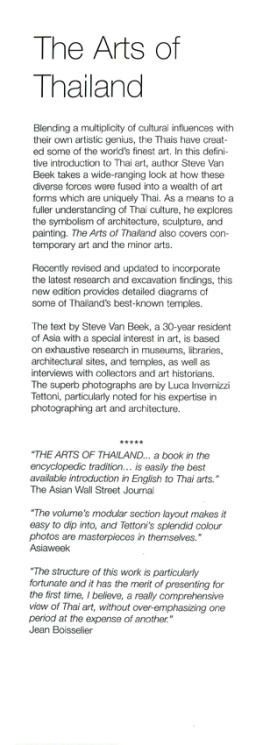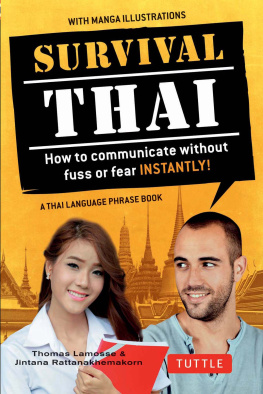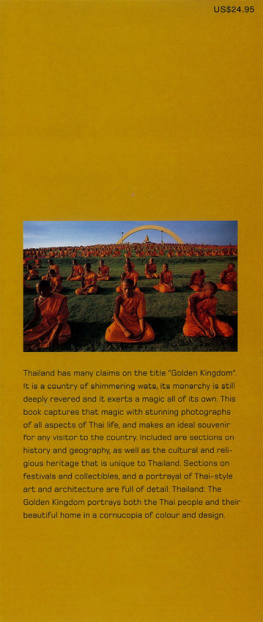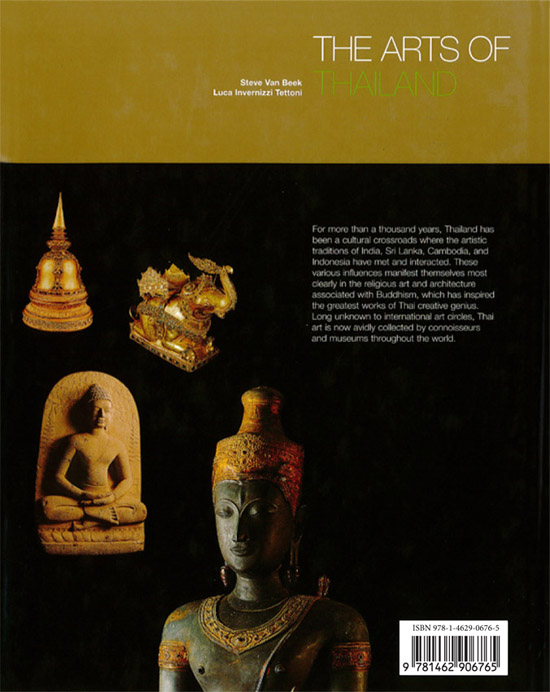BUDDHISM AND THE LIFE OF BUDDHA
There is much of the miraculous about the events in Buddha's life, most of them undoubtedly added long after his death by overzealous disciples and believers trying to appeal to a broad audience steeped in Hindu mythology or spirit worship In attempting to relate Buddha's life and at the same time shed some light on some episodes which appear in paintings, lintels and votive tablets, it is necessary to include several of these somewhat fantastic elements, many of which are unique to Thailand.
B uddhist doctrine, adapted in part from Hindu beliefs, contends that each man and woman is condemned to die and be reborn endlessly in a quest to become perfect. The good or bad that one does in this life determines whether he or she will be reborn as a higher or lower being. In Buddhist belief, good can be accumulated and even transferred, as when a dutiful child performs acts of merit to aid a dead parent to be reborn as a higher being. If one is successful in evolving lifetime by lifetime into a better person, he eventually reaches perfection whereupon he breaks the cycle of rebirths and passes into nibhan (nirvana), an ethereal state of eternal bliss.
I n Theravada Buddhist belief professed by Thais, the man known to the world as "Buddha" was the fourth of five Great Teacher Buddhas (there are numerous other Buddhas, called Pacheka, who do not preach). This fourth Buddha, Gautama Buddha, died in 543 B.C. Buddhist tradition holds that the fifth and final Great Buddha, the Maitreya, will appear on earth 5,000 years after Gautama Buddha, or in the year 4457 A.D.
Gautama Buddha was the final, 500th incarnation of a single being. Each of these incarnations has been recounted in a body of works known in Pali as the Jataka Tales, and in Thai as Chadok. The last ten, collected in a work titled the Dasajati (in Thai Tosachat), are the most important.
B uddha was born Prince Siddhartha of the Sakya clan in the city of Lumbini in present-day Nepal. His greatness was portended in a dream his mother, Maya, had wherein she was carried to the Himalayan forests by heavenly deities where a white elephant circled her bed three times and entered her body through the right side to become the embryonic Buddha.
Standing upright and with one hand holding a tree branch, the queen gave birth to her child. Astrologers predicted that the boy would one day become a Buddha or a Chakravartin, a Universal Monarch. One sage, Asita, swore the boy would become a Buddha at which, miraculously, a Buddha appeared on top of Asita's head as verification of the truth of the old sage's words.
P rince Siddhartha married at the age of years and settled down to a life of luxury in the palace, secluded from the world outside. His elongated earlobes (as often witnessed in sculpture and murals), distended by the weight of heavy earrings, are references to this period in his life. One day, when he was 29 years old, the prince ventured for the first time beyond the palace walls and was confronted by the harsh reality of life as it is lived by ordinary men. As he traveled along a country road, he encountered an old man, a sick man, a dead man and a holy man. Shocked and saddened by what he saw, he returned to the palace and began to ponder the question of why man should be condemned to suffer such torment. Unable to gain a satisfactory answer from the wise man of the court, he determined to find out for himself. Recalling the serence light which shone on the face of the holy man, he decided that by emulating him he might find the answer he was seeking. As he was considering leaving his luxurious life, it was announced that his wife had given birth to a son. The news momentarily dissuaded him from his quest but after further reflection, the young prince decided to sever his links with his past. One night, he left his family, never to return.
P rince Siddhartha traveled deep into the forest and at the side of a stream cut off his hair, donned a plain robe, and took up an alms bowl to become a wandering Hindu ascetic. For the next six years, he starved himself and inflicted all forms of abuse on his body in the hope that self-abnegation and pain would reveal an answer. Such mortification led him nowhere, and he realized that instead of pursuing extremes he should seek a Middle Way. On emerging from a fast, a nobleman's daughter, Sujata, prepared him a delicious soup in a golden bowl. When he finished, Sujata gave Gautama the bowl, which he placed in a brook asking that it float upstream as a sign if he was destined to become the Buddha. It did.
He began to meditate on the causes of human suffering and at last, beneath a tree, Buddha at the age of 35 found the answer he had been seeking: Man suffers because of discontent, lust and craving for what are, in the end, ephemeral goals and material objects. Life is impermanent, and the things of this world cannot protect one from unhappiness or from the inevitable: death and rebirth. Only by extinguishing desire and attachment to material objects and to other human beings can one find peace.
W hile grappling with the ramifications of this revelation, Gautama was assailed by the forces of darkness in the form of Mara's three lascivious daughters and myriad other temptations set loose to veer him from his path. Through force of mind and through the merit he had accumulated in past lives, he was able to withstand their onslaught. When Mara asked him, "Who can vouch for your goodness?", Gautama pointed his right hand towards the ground and said, 'The earth shall be my witness." At that moment, the earth goddess, Toranee, appeared and wrung from her hair a torrent of water which washed away Mara, his daughters and all other evils and temptations. Gautama continued to meditate through the night and at dawn was suffused with the pure light of supreme understanding.
In the seven weeks following his Enlightenment, Buddha meditated at seven locations in the vicinity of Bodhgaya. In the fifth week, while seated at the edge of Lake Muchalinda, a terrible storm arose causing the waters of the lake to rise. Seeing that Buddha was lost in thought, the naga king, Muchalinda, slipped his coils under Buddha's body, lifting him above the threatening flood. At the same time he spread the hoods of his seven heads to shelter the Enlightened One from the driving rain.
B uddha contemplated on whether to enter nirvana immediately or to remain on earth to preach his new-found wisdom. Brahma and other deities descended to earth to plead with him to remain as a teacher. Buddha envisio ned a marshy pond of lotuses with some blossoms immersed in mire, some floating on its surface and others rising above it. T hose deep in the water were like people sunk in evil; for them no help was possible. Those which had risen far above it had no need of help. Those people trying to rise above evil, but uncertain about how their souls might ascend, needed aid to reach salvation. It was then that Buddha elected to remain on earth.
H is first sermon was preached at Deer Park in Sarnath to the five monks who had traveled with him during his six years as an ascetic. To them he explained his doctrine, sending it whirling like a wheel into the world, an act symbolically recreated by the Dhammachakra mudra or "Setting the Wheel of the Law in Motion." He then began traveling to seek new converts to his doctrine. Buddhist texts in Southeast Asia include an episode not found in the Sanskrit or Pali originals in which Buddha is confronted by the proud Emperor Jambupati, who refuses to listen to the words of a lowly teacher. Buddha causes a splendid palace to appear and adorns himself with a crown and jewelry. In this guise, he invitesjambupati to visit him. T he emperor is impressed by this display of magnificence. Buddha, however, rebukes him by pointing out that earthly glory is an empty achievement. Perceiving the lesson, Jambupati abandons his throne and becomes a monk. It is thought that this story is the explanation for the vast numbers of Adorned Buddhas created by Southeast Asian Theravada sculptors.













